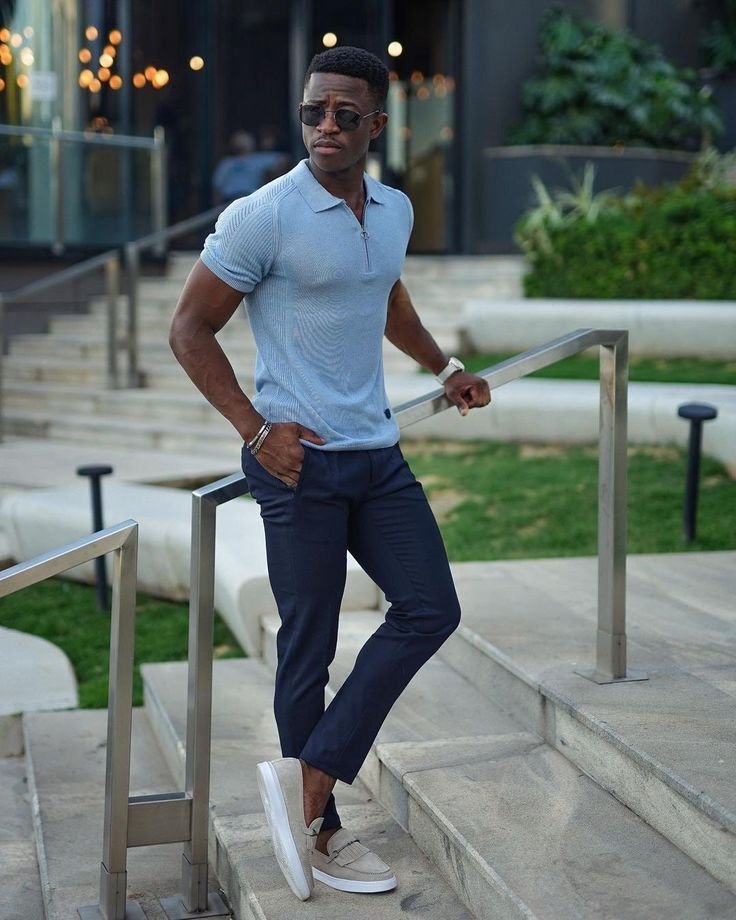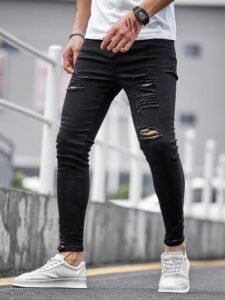Pattern mixing is a powerful styling technique that allows you to create stylish and unique outfits. By combining different patterns with men’s skinny pants and chinos, you can elevate your fashion game and make a bold fashion statement. In this article, we will explore the art of pattern mixing and provide you with valuable tips and techniques to master this trend. Whether you’re a fashion enthusiast or someone looking to experiment with new styles, learning how to mix and match patterns will enhance your wardrobe and give you a fresh and fashionable look.

Table of Contents
Understanding Pattern Mixing
Pattern mixing is the art of combining different patterns in one outfit to create visual interest and a unique aesthetic. By pairing patterns, you can add depth and dimension to your outfits, making them more visually appealing. Understanding the different types of patterns is crucial for successful pattern mixing. Common pattern types include stripes, checks, plaids, florals, and geometrics. Each pattern type has its own characteristics and visual impact, and learning about them will help you create cohesive and well-balanced looks.
Pattern mixing has gained significant popularity in men’s fashion, with fashion-forward individuals embracing this trend to express their personal style. It allows you to break away from traditional fashion norms and showcase your creativity and confidence in styling.

Principles of Pattern Mixing
To achieve successful pattern mixing, it’s important to understand and apply certain principles. Here are key principles to keep in mind:
A. Scale and Proportion:
When mixing patterns, consider the scale and proportion of each pattern. Pairing patterns of similar scale creates a sense of balance and harmony. For example, if you’re wearing skinny pants with narrow stripes, you can pair them with a shirt that has small checks or subtle patterns. This creates a cohesive and visually pleasing look.
B. Color Coordination:
Coordinating colors between different patterns is essential for a cohesive and well-executed outfit. Look for common colors or complementary hues that tie the patterns together. You can also experiment with different shades or tones of the same color family. For example, if you’re wearing a floral-patterned chino, choose a shirt with a color that complements one of the colors in the floral print.
C. Contrast in Pattern Style:
One of the key elements of successful pattern mixing is creating contrast in pattern styles. This means pairing patterns with different aesthetics or motifs. For instance, you can pair a bold, geometric-patterned chino with a more subtle, organic-patterned shirt. This contrast adds visual interest and creates a dynamic and well-balanced outfit.
By applying these principles, you can achieve a visually appealing and cohesive pattern-mixed outfit that reflects your personal style and fashion sensibilities.

Tips for Mixing Patterns with Men’s Skinny Pants and Chinos
Now that we’ve covered the principles of pattern mixing, let’s explore some practical tips to help you mix patterns with men’s skinny pants and chinos:
Start with a Solid Foundation:
If you’re new to pattern mixing or prefer a more subtle approach, begin by pairing your patterned pants with solid-colored tops. This allows the patterns to take center stage while maintaining a balanced look. For example, pair a pair of skinny pants with a solid-colored shirt or sweater.
Mix Patterns of Different Sizes:
Combining patterns of different sizes can create visual interest and add depth to your outfit. Pair larger-scale patterns with smaller-scale ones to achieve a balanced and dynamic look. For instance, you can pair wide-striped skinny pants with a shirt featuring a micro-check pattern.
Harmonize Colors between Patterns:
When mixing patterns, it’s important to ensure that the colors within each pattern harmonize well. Look for common colors or complementary hues that tie the patterns together. This creates a cohesive and unified look. For example, if you’re wearing a chino with a floral print, choose a shirt that features one of the colors from the floral pattern.
Anchor the Outfit with Neutrals:
To balance out the patterns and create a cohesive look, anchor your outfit with neutral-colored pieces. Neutral colors such as white, black, gray, or beige provide a clean and polished backdrop for pattern mixing. For example, pair a pair of patterned chinos with a neutral-colored blazer or a white shirt.
Pattern Mixing Techniques for Men’s Skinny Pants
When it comes to pattern mixing with men’s skinny pants, there are several techniques you can try:
A. Mixing Stripes and Checks:
Combining different types of linear patterns can create a visually appealing and stylish outfit. Pair pinstriped skinny pants with a shirt featuring a subtle check pattern. This combination adds depth and visual interest to your look.
B. Blending Geometric Patterns:
Experimenting with geometric patterns can give your outfit a modern and edgy vibe. Pair a pair of skinny pants with a geometric pattern with a shirt or sweater featuring a complementary geometric pattern. This creates a harmonious and visually striking look.
C. Pairing Patterns with Solids:
Balancing patterns with solid-colored garments is a great way to create a cohesive outfit. Pair patterned skinny pants with a solid-colored shirt or sweater. This allows the patterned pant to take center stage while maintaining a balanced and polished look.

Pattern Mixing Dos and Don’ts
A. Dos: Experimenting, embracing creativity, and developing personal style When it comes to pattern mixing with men’s skinny pants and chinos, there are several dos to keep in mind:
- Do Experiment: Pattern mixing is all about exploring and pushing boundaries. Don’t be afraid to try different pattern combinations and take risks. Experimentation is the key to discovering unique and stylish outfits.
- Do Embrace Creativity: Pattern mixing allows you to express your creativity and showcase your personal style. Have fun with it and let your imagination run wild. Mix patterns that resonate with your individual taste and make a statement.
- Do Develop Personal Style: Pattern mixing is an opportunity to develop your own signature style. Experiment with different patterns, colors, and styles to find combinations that reflect your personality and fashion sensibilities. Use pattern mixing as a way to stand out and make a fashion statement.
B. Don’ts: Overwhelming the outfit with too many patterns, neglecting balance and cohesion To ensure successful pattern mixing, it’s important to avoid certain pitfalls. Here are some don’ts to keep in mind:
- Don’t Overdo It: While pattern mixing can be exciting, avoid overwhelming your outfit with too many patterns. Aim for a balanced and cohesive look by selecting a maximum of three patterns in one ensemble. Overcrowding the outfit with numerous patterns can create visual chaos and diminish the impact of each pattern.
- Don’t Neglect Balance and Cohesion: Achieving balance and cohesion is crucial in pattern mixing. Ensure that the patterns complement each other and work harmoniously together. Consider the scale, color, and style of each pattern to create a cohesive and visually pleasing outfit. Remember, the goal is to create a statement look, not a chaotic clash of patterns.
C. Mention related search query: “Common pattern mixing mistakes to avoid” When it comes to pattern mixing, it’s important to be aware of common mistakes that can detract from your overall look. Avoiding these mistakes will help you achieve successful pattern mixing. Here are a few common pattern-mixing mistakes to avoid:
- Clashing Patterns: Mixing patterns that clash can create a chaotic and unappealing outfit. Be mindful of the patterns you’re combining and ensure they work together harmoniously. Consider factors such as scale, color coordination, and pattern styles to create a visually pleasing combination.
- Ignoring Proportion: Proportion is key in pattern mixing. Neglecting the scale and proportion of patterns can throw off the balance of your outfit. Pair patterns of similar scale for a well-balanced look, and avoid combining patterns of the same size or scale, as they can compete for attention.
- Overlooking Color Coordination: Neglecting color coordination can result in a disjointed and mismatched outfit. Choose patterns that share at least one color to create a cohesive look. Experiment with complementary or analogous color schemes to create a visually pleasing combination.
- Neglecting the Outfit’s Purpose: Consider the occasion and the desired level of formality when pattern mixing. Certain patterns may be more appropriate for casual settings, while others can work well for dressier occasions. Align your pattern choices with the overall vibe and purpose of the outfit.
Conclusion
In conclusion, pattern mixing with men’s skinny pants and chinos is a creative and stylish way to elevate your fashion game. By following the dos and avoiding don’ts of pattern mixing, you can create visually captivating outfits that reflect your personal style and fashion sensibilities.
Pattern mixing allows you to express your creativity, experiment with different combinations, and develop your own unique fashion identity. Embrace the opportunity to stand out from the crowd and make a fashion statement by mixing and matching patterns with confidence.
As you explore the world of pattern mixing, Nicerior’s collection of men’s skinny pants and chinos provides a versatile and stylish foundation for your pattern-mixed outfits. With a range of patterns and colors to choose from, Nicerior offers the perfect pieces to help you create fashionable and trendsetting looks.
Frequently Asked Questions (FAQs)
A. How do I mix patterns without clashing?
To mix patterns without clashing, consider the scale, color coordination, and style of each pattern. Pair patterns that have a similar color scheme or share at least one common color. Additionally, mixing patterns of different scales and styles creates visual interest without overwhelming the outfit.
B. Can I mix patterns with different colors?
Yes, you can mix patterns with different colors. The key is to ensure that the colors within each pattern harmonize well. Look for common colors or complementary hues that tie the patterns together and create a cohesive look.
C. What patterns work best for beginners in pattern mixing?
For beginners, it’s best to start with patterns of similar scale and colors that complement each other. Pairing stripes with checks or simple geometric patterns can be a good starting point. As you gain confidence, you can experiment with more complex pattern combinations.
D. Can I mix patterns with different textures?
Yes, mixing patterns with different textures can add depth and visual interest to your outfit. Consider pairing a textured pattern, such as a houndstooth or tweed, with a smoother or more delicate pattern to create a contrast in textures.
E. How many patterns should I mix in one outfit?
To maintain a balanced and visually appealing look, it’s generally recommended to mix a maximum of three patterns in one outfit. This ensures that the patterns don’t overwhelm each other and allows for a cohesive and well-composed ensemble. Remember to consider the scale, color coordination, and style of each pattern when making your choices.




